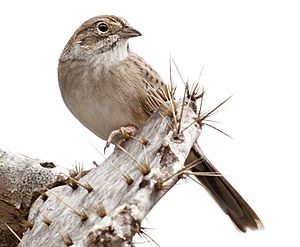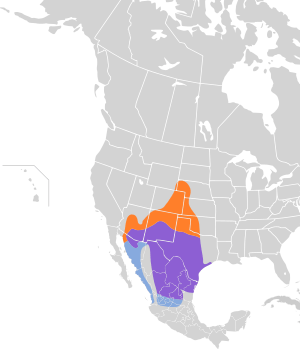Cassin's sparrow facts for kids
Quick facts for kids Cassin's sparrow |
|
|---|---|
 |
|
| Conservation status | |
| Scientific classification | |
| Genus: |
Peucaea
|
| Species: |
cassinii
|
 |
|
| Synonyms | |
|
Aimophila cassinii |
|
The Cassin's sparrow (Peucaea cassinii) is a medium-sized bird that belongs to the sparrow family. You can find this bird, which is a type of passerine (a perching bird), in areas stretching from western Nebraska all the way down to north-central Mexico.
Contents
About the Cassin's Sparrow
How Was the Cassin's Sparrow Named?
The first Cassin's sparrow was officially described in 1852. A scientist named Samuel W. Woodhouse found a specimen (a sample bird) near San Antonio, Texas. He named the bird after John Cassin, who was a famous bird expert from Philadelphia.
Over the years, scientists have changed the sparrow's scientific group, or genus. It was first called Zonotrichia cassinii. Later, it moved to the genus Peucaea, then to Aimophila. This happened because scientists didn't know much about these birds' bodies or how they lived.
In 2010, after studying the bird's genes, body shape, and songs, the American Ornithologists' Union decided to move the Cassin's sparrow back to the Peucaea genus. So now, its scientific name is Peucaea cassinii again. There are no different types or "races" of the Cassin's sparrow.
What Does the Cassin's Sparrow Look Like?
The Cassin's sparrow is a medium-sized bird, usually about 5 to 6 inches long. It has a long, rounded tail with white tips that you might see when it flies. Its body is mostly grayish-brown. It has dark marks on its back and sides.
This sparrow looks a lot like the Botteri's sparrow. However, the Botteri's sparrow is usually a lighter gray. The easiest way to tell them apart is by their unique songs. Both male and female Cassin's sparrows look similar, though males are generally a bit larger.
Feathers and Colors
The Cassin's sparrow doesn't have many bright or flashy markings.
- Its head is brown with streaks of gray and dark brown.
- It has a light buff-colored stripe above its eye.
- The beak is brownish-gray, darker on top.
- Its eyes are dark brown.
- The chin, throat, and chest are pale gray or brownish-gray.
- The belly is whitish, with a few dark brown streaks on its sides.
- The back feathers are brown or gray with a hint of rust. They have dark spots, making them look a bit scaly.
- Its wings are brown. Some feathers have light tips, forming a faint bar on the wing.
- The tail is mostly dark brown. The two middle tail feathers are pale brownish-gray with a dark stripe. The outer tail feathers have pale gray or white tips. These white tips can wear off by late summer.
- Its legs are a dull pinkish color.
Young Sparrows
Young Cassin's sparrows look similar to adults. They have brown backs with light-tipped feathers and darker streaks. Their chest and throat also have light streaks.
Some Cassin's sparrows, especially in the eastern part of their home range, can be more reddish-brown on top. They might also be slightly lighter underneath. These birds can even have plainer tails with less clear markings.
Cassin's sparrows have a special way of changing their feathers, called molting. Young birds replace all their main body feathers twice within their first six months. Adult birds slowly replace their body feathers throughout the breeding season.
Cassin's Sparrow Life and Habits
The Sparrow's Song
The Cassin's sparrow is famous for its song, which sounds like titi-trrrrrrrrrrr, tyew tyew. Only the male sparrows sing this song. They are known for a special behavior called "skylarking." This is when a male flies high into the air, then glides down while singing. It's one of the few sparrows that does this!
People in places like Midland County, Texas, say that hearing the "high, sweet trills" of Cassin's sparrows is a sign that spring is coming. Adult sparrows also have a second flight song with "chips" when they feel nervous. Young chicks make a series of "sips" when they sing. Males sing from February to September, and their song is the easiest way to identify them.
The main song has six parts. It starts with a soft double or single note, then a long, high musical trill, and usually two lower, musical notes. Each bird's song is a little different, which helps scientists tell individual males apart. They also make other calls, like "chitter" calls and "chip" notes. These calls are used for things like staying connected with their mate, talking to their young, warning others of danger, or defending their territory. Sometimes, they might sing at unusual times of the year if conditions are strange.
When not flying, male sparrows sing from low bushes, grass, or the ground. At the start of the breeding season, they sing from a fixed spot. Flight songs and skylarking become more common later, especially when females return. During a flight song, the male flies up from a bush to about 15 to 30 feet in the air. Then, he sings as he glides or flutters down to a nearby bush or the ground. While coming down, their wings are held flat, their head is arched back, and their tail is raised. They can be heard singing from mid-February to early September, depending on the location. Some people have even reported them singing a lot at night during the peak season.
What Do Cassin's Sparrows Eat?
The Cassin's sparrow's diet includes both insects and seeds. In the summer, they mostly eat insects. This includes grasshoppers, caterpillars, and beetles. They also eat true bugs, ants, bees, wasps, weevils, spiders, snails, and moths. Young sparrows are fed almost entirely insects. One study found that 95% of the insects given to baby sparrows were grasshoppers.
However, some studies show that adult sparrows eat about half insects and half plant material during the breeding season. When they are migrating, they eat mostly insects. There's even a report of them eating flower buds from a blackthorn bush. In the fall and winter, Cassin's sparrows eat seeds from weeds and grasses. They particularly like seeds from chickweed, plantain, woodsorrel, sedge, panicum, and sorghum.
Cassin's sparrows usually find their food on the ground. They hop around in open areas, picking up items from the ground or from plant stems. If they get scared, they fly to a bush or fence, or they might drop back into the grass. They forage slowly and carefully. When baby birds are present, they also look for food within mesquite and other shrubs. Young sparrows seem to get most of their food this way, rather than on the ground.
Where Do Cassin's Sparrows Live?
Cassin's sparrows are often found in brushy grasslands. They are known to be nomadic, meaning they move around a lot. Their numbers can go up and down each year. You can find them in the south-central states of the U.S. They are rarely found in the northern parts of their range, possibly because of less rainfall there.
These birds build their nests in the grass, using a mix of different weeds and grasses. The female usually lays 3 to 5 eggs.
Cassin's sparrows use slightly different habitats depending on where they live. However, they always need two main things: grass (usually short grass) and shrubs. The shrubs can be actual bushes like mesquite, sage, hackberry, or oaks. They can also be other plants that look like shrubs, such as yucca, prickly pear cacti, ocotillo, or even tall clumps of bunch grasses.
The shrubs are important because the birds use them as perches to sing from or to launch themselves for their flight songs. They also often build their nests in low shrubs. When young birds are around, the sparrows especially like mesquite thickets. So, good Cassin's sparrow habitat can range from mostly grassland with a few shrubs to shrubland with some grass cover.
Images for kids
See also





